How Ermak took Siberia
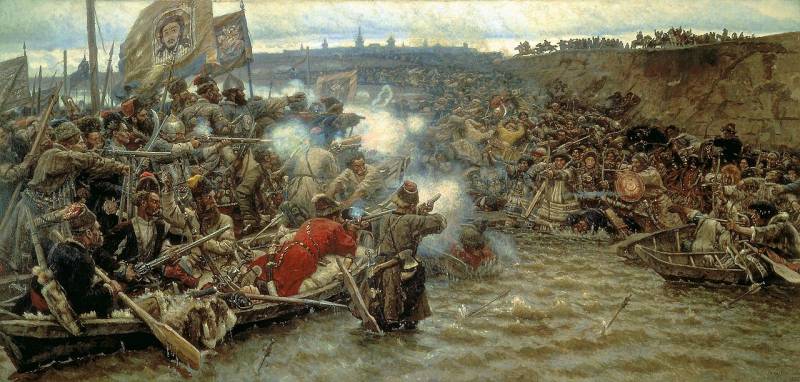
V. Surikov, "The conquest of Siberia by Ermak Timofeevich"
Ermak Timofeevich
The origin of Yermak is not exactly known, there are several versions about this.
- wrote the historian N. Karamzin. So, some researchers argued that the Russian hero comes from the Urals, from the Chusovaya River, others from the Don, still others from the Russian North, and fourth from the Volga.
There is no reliable information about the surname. One thing is clear, he enjoyed great prestige among the Cossacks. Ermak Timofeevich is the only ataman who was called by his first name and patronymic. Ermak is not a nickname, but a name, Ermolai-Eremey or Herman. There are other versions: for example, Siberian historians claimed that the full name of Yermak sounded like Vasily Timofeevich Alenin.
Apparently, Yermak walked along the Volga, Kama and Chusovaya. Fought with the Crimean Tatars and Turks at the Battle of Molodi in 1572. During the Livonian War, he led the Cossack hundred in the royal service. Under the command of governor Khvorostinin, he participated in a successful campaign in Lithuania in 1581, reached Mogilev and fought near Shklov. A letter from the Lithuanian commandant Mogilev Stravinsky, sent at the end of June 1581 to King Stefan Batory, has been preserved, in which “Ermak Timofeevich is a Cossack ataman” is mentioned. In the same year, the chieftain participated in lifting the siege of Pskov, and in February 1582 in the battle of Lyalitsy, where Khvorostinin defeated the Swedes.
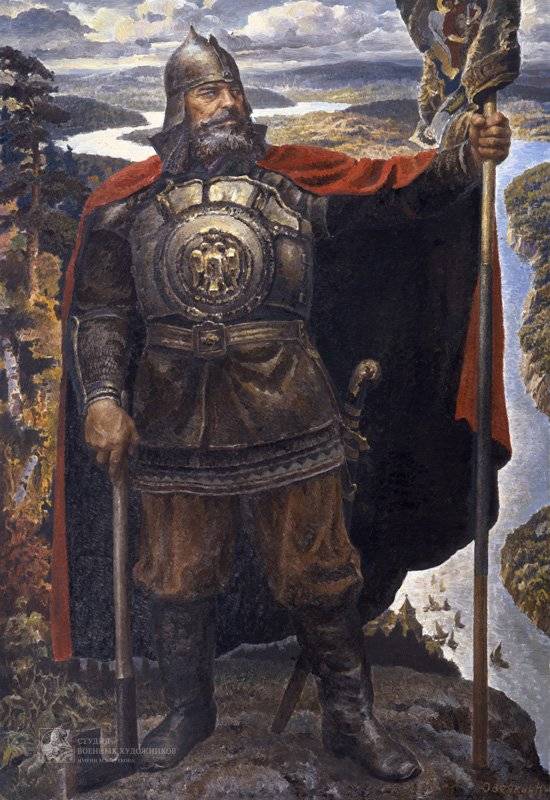
N. V. Ovechkin. Ermak
The problem of Khan Kuchum
A descendant of Genghis Khan, a relative of the ruling Shibanid dynasty in the Bukhara Khanate, Khan Kuchum, relying on the support of Bukhara, fought against the Siberian Khan Yediger. Kuchum brought with him detachments of Nogais, Uzbeks and Kazakhs. Ediger, unable to repel the invasion on his own, asked for help from the Russian Tsar Ivan the Terrible, who at that time had already taken Kazan. In 1555, Yediger sent envoys to Ivan Vasilievich with a request to "take Siberia into his hands", promising to pay tribute to the tsar regularly.
However, the Siberian Khanate was removed from the Russian kingdom, and Moscow was busy with other directions. In 1563, Kuchum seized power in the Siberian kingdom. Yediger and his brother were executed. Forced Islamization of the local population began. This caused resistance and riots. The new dynasty relied on squads from Central Asia. Kuchum subjugated the Khanty-Mansiysk tribes that lived on the Ob and the Urals, the Barabans and part of the Bashkir tribes that lived on the eastern slopes of the Urals. The borders of the Siberian Khanate in the north reached the Ob, in the west they crossed in some places to the European side of the Urals, in the south they passed along the Baraba steppe.
Having consolidated his power, Kuchum stopped paying the agreed tribute to Moscow. His detachments reached Perm, disturbing the possessions of the Stroganovs. In 1575, Kuchum's brother Mametkul invaded the estate of the Stroganovs. The fortified towns withstood, but the Siberian soldiers killed many Ostyaks who were in Russian citizenship, took away women and children. The Russian settlement beyond the Urals was destroyed. This caused an attempt by the Nogais to overthrow the power of Moscow and unrest in the former Kazan kingdom.
Then Kuchum calmed down for a while. But when information reached him that the Poles and Swedes were pushing the Russians, he grew bolder. Siberia (the capital of the Khanate, other names - Kashlyk, Isker) entered into an alliance with the Nogais. In the spring of 1581, the Nogai Horde of Prince Urus invaded Russian lands. And the vassal of Kuchum, the Pelym prince Ablygerim, attacked the lands of the Stroganovs.
Siberian campaign
There was no point in asking the tsarist government for an army. The hard war continued. But the Stroganov industrialists had the right to recruit people themselves and turned to the Cossacks. At this time, Yermak's detachment, in search of a new enterprise, went to the Volga, but here the tsarist regiments were transferred against the rebels in the former Kazan Khanate. And the local Cossacks, who accidentally attacked the tsar's embassy, which was negotiating with the Nogais, fled from the tsar's wrath to Yaik (Ural). Yermak also leaned on Yaik. There the Cossacks gathered a circle and accepted the invitation of the Stroganovs. Ermak Timofeevich became the great ataman, his "peer" (deputy) - Ivan Koltso.
The Cossack squad (more than 500 fighters) arrived in the possession of the Stroganovs. They were professional, hardened and stern warriors. An analogue of the modern army special forces. Well armed: 3 small cannons and 300 squeakers. The Cossacks went up the Kama, and in June 1582 they arrived on the Chusovaya River, in the Chusovskie towns. Arrived on time. Kuchum sent a large detachment led by his son Alei to the Russian possessions - the Bukhara guard, squads of his Murzas, Nogais and Bashkirs. The Cossacks in a fierce battle near the Chusovsky town repulsed the attack of the enemy. Then Aley went north, to Sol-Kamskaya. Enemies set fire to the town, broke into the settlement and staged a massacre. Then Aley laid siege to Cherdyn, the main city in the Permian land. The fortress was barely repulsed.
Ermak decided not to sit on the defensive, but to hit the enemy himself, while the main forces of the Siberians were on the Kama. Attack the headquarters of the Siberian king. Later, the Stroganovs began to lie (the Stroganov Chronicle) in order to exaggerate their merits. Like, they came up with the Siberian operation. They reinforced Yermak's detachment with Lithuanian and German soldiers. In fact, they only defended their possessions. On the contrary, the Cossacks demanded to launch an offensive, literally knocked out supplies and equipment from the stingy industrialist Maxim Stroganov. Perhaps they received reinforcements from local warriors, they also took local guides.
It is worth noting that the campaign began without the support of Moscow. So, the governor of Cherdyn, Perepelitsyn, who had already suffered at the hands of the Cossacks when he negotiated with the Nogais, wrote a denunciation to the Stroganovs. Like, industrialists sent "thieves" to Siberia. Meanwhile, negotiations were underway with the rebel tribes. And the industrialists, on the contrary, sent mercenaries to rob their neighbors and provoked a new war.
The tsar got angry, and an angry letter went to Kama, because the Stroganovs hired "thieves" who quarreled with the Nogai Horde and beat the Nogai ambassadors on the Volga. True, the tsar had already somewhat calmed down and canceled the order on the death penalty for the Cossacks. The Nogais again disturbed our possessions, and the Cossacks were excellent warriors. Ivan Vasilyevich ordered the industrialists to return the Cossacks back and use them to protect the Perm places.
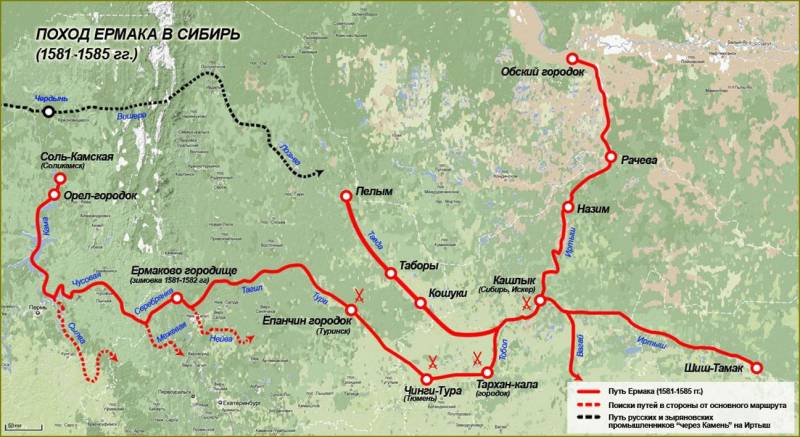
To Siberia!
The royal charter was late. When it was written, the Siberian Khanate had already been defeated. Subsequently, legends and traditions sang a 3-year campaign with winter quarters and many battles. But the Cossacks simply did not have the strength, resources, rear base for such a campaign. If Kuchum had managed to gather an army - a 10-strong army, he would simply crush the Russian soldiers.
It was a swift raid. Heavy and over the top. It was necessary to get ahead of Aley's army, to be in time before the freeze-up. From Chusovaya, the Cossacks on boats-strugs climbed along its tributary, the river. Serebryanka. At the pass of the Ural Mountains, several heavy plows had to be left. The lungs were dragged by dragging into the river. Zhuravlik (Zharovlya), then went along the Siberian rivers - Baranchuk, Tagil, Tura and Tobol. There were skirmishes with the enemy near Yepanchin town, in the yurt of Karachi.
When Kuchum found out about the appearance of the Cossacks, he did not attach any serious importance to this. Small detachment, plunder and leave. But the Cossacks continued to move forward. The Siberian king gathered an army and appointed his best governor, nephew Mametkul (Muhammed-Kuli), as commander. In August, this army was defeated by Yermak on the banks of the Tobol, near the tract of Babasany. Obviously, the Siberians underestimated the enemy, relying on their numerical superiority.
An approximate Khan Tauzak said:
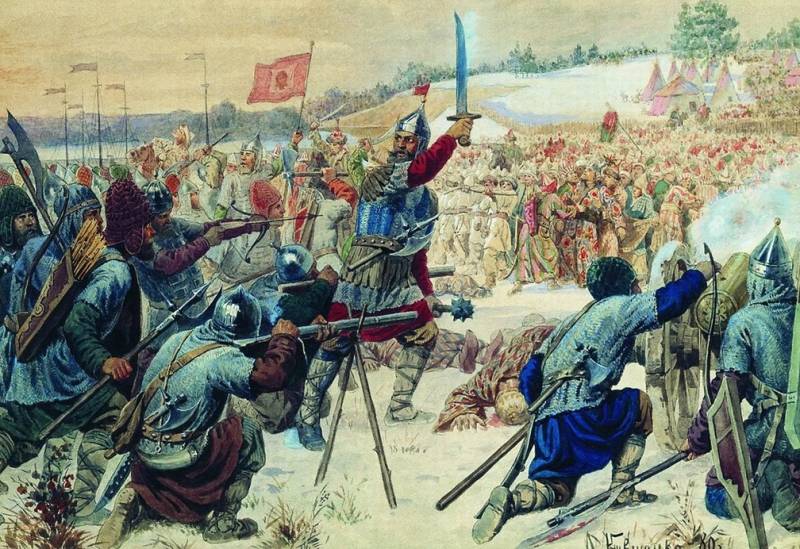
The conquest of Siberia by Yermak. A. Kivshenko
Capture of the capital
The Cossacks were approaching the Siberian capital. Qashlyk did not have strong fortifications. It was the headquarters of the king on the site of the ancient settlement "Siberia". Therefore, the Siberians organized a defense at the foot of the mountain on the Chuvashev Cape. They built a notch there, stationed the army. When Yermak's planes reached the Irtysh to Siberia-Kashlyk, the Cossacks saw a large army and became shy, "desiring to flee in the night."
Ataman gathered a circle. The supporters of the offensive won.
We cannot go back in shame. If God helps us, then even after death our memory will not fail in those countries, and our glory will be eternal.”
On October 23 (November 3), 1582, the Cossacks stormed the enemy positions. Kuchum really gathered a large army. But these were not the best, they had not yet returned from a campaign on Russian lands. It was a hastily gathered militia of various tribes, of which many hated the southern newcomers.
With fire, the Cossacks drove the enemies away from the shore, landed a detachment. At the notch, the attack bogged down, the attackers were bombarded with arrows. The Cossacks retreated to the river. Siberians grew bolder, Mametkul ordered to make passages in the notches. The Siberian army counterattacked, and itself came under fire from the ship's army. Having suffered heavy losses, the Siberians fled. Mametkul tried to stop his army, but was wounded. The absence of the commander increased the panic. The Cossacks went on a new attack and captured the fortification.
The Siberian princes, seeing the failure of Kuchum, took their squads home. The Siberian king collected as much good as he could and fled from the capital. On October 26 (November 5), 1582, Yermak entered the city of Siberia, abandoned by the Tatars. A few days later, local residents began to send gifts. Yermak greeted them with "kindness and greetings" and released them "with honor." Yermak imposed yasak (an annual tax in kind) on all those who came. They took an oath from the leaders, they were now considered as subjects of the Russian Tsar.
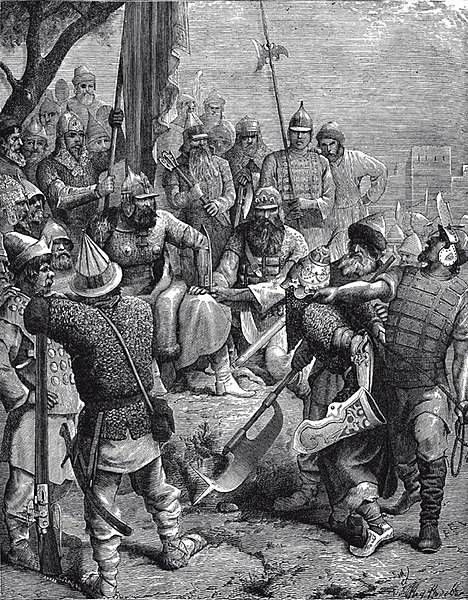
Ermak's celebration. (Reception of Prince Magmet-Kul, taken prisoner). Illustration from the Niva magazine
Annexation of the Siberian land
And the war continued. Kuchum and Mametkul retained their squads. Alei's army came up. One of the small detachments of Cossacks who went for supplies was ambushed. The Cossacks died. Yermak immediately attacked.
In December 1582, a stubborn and bloody battle took place on Lake Abalak - "the scolding of Velia for many hours." The Cossacks suffered heavy losses, but prevailed. In February 1582, the Cossacks dealt a new strong blow to Kuchum, defeating and capturing Mametkul on the Vagai River. Mametkul was sent to Moscow. Tsar Fyodor Ivanovich received him "with great honor" and granted him estates. The Siberian prince bravely fought for the new homeland against the Swedes and Crimeans.
The main forces of the Khan were defeated. His power crumbled. Local leaders and tribes went over to the side of the Russians. Seyid Khan, the nephew of the deceased Ediger, spoke out against Kuchum. The vizier Karacha fell away from the king. And the Cossacks "walked" in Siberia. They moved their base to the safer Karachin Island at the mouth of the Tobol. From here they made trips to the surrounding lands, along the Irtysh and Tavda. Some tribes obeyed voluntarily, others got out of the power of the khan, but they did not want to obey the Cossacks. They were forced into submission.
The Cossacks in the circle decided to send an embassy to Moscow. In the spring of 1583, a village of 25 people left for Rus', headed by Alexander Ivanov (Cherkas) and Savva Boldyrya. The village did not visit the Stroganovs, the Cossacks did not consider the industrialists to be their superiors. With the help of local residents, they found a more convenient way: down the Irtysh and Ob, and “through the Stone (as the Ural Mountains were called - ed.) they passed the Sob river to the Empty Lake.” The ambassadors reached Moscow in the summer or autumn of 1583. They bowed to Ivan the Terrible with a huge Siberia. Another kingdom fell at the feet of the Terrible Tsar. Ivan Vasilyevich greeted the Cossacks affectionately, gave gifts. He sent reinforcements.
Rus' again turned into a huge continental power-empire. She became the true heiress of the Horde Empire and Great Scythia. Another hotbed of hostility was destroyed, which fueled the Kazan and Bashkir uprisings. Kazan land was no longer a border, inland region of Russia. Before the Russian state and people, boundless prospects of the movement “meet the sun”, to the east, came off. After the difficult Livonian War, which did not lead to success, Russia again won a great victory.
The war for Siberia continued for a long time. Cossacks and atamans perished. Bogdan Bryazga was ambushed and killed, while Nazim was captured, Nikita Pan was killed. Murza Karacha dealt a sneaky blow. He announced that he was ready to accept Russian citizenship. But at the feast he killed the detachment of Ivan the Ring. Then the detachment of Yakov Mikhailov died. The Cossacks withstood a heavy siege in Qashlyk. In August 1585, Yermak was ambushed and killed in battle. The remnants of the Cossack squad (90 fighters) had to leave Siberia. But already in 1586-1587. Russian governors approved the conquests of the Cossacks. They founded Tyumen and Tobolsk. The Cossacks, Yermak's comrades-in-arms, also returned to Siberia, followed by new fighters from the Volga and Don. This is how the Siberian Cossack army began to take shape.
Kuchum continued to resist and made raids until 1601, when he was killed. His heirs continued to muddy the waters until the 1620s and 1630s, but they could no longer change anything. Siberia became Russian.
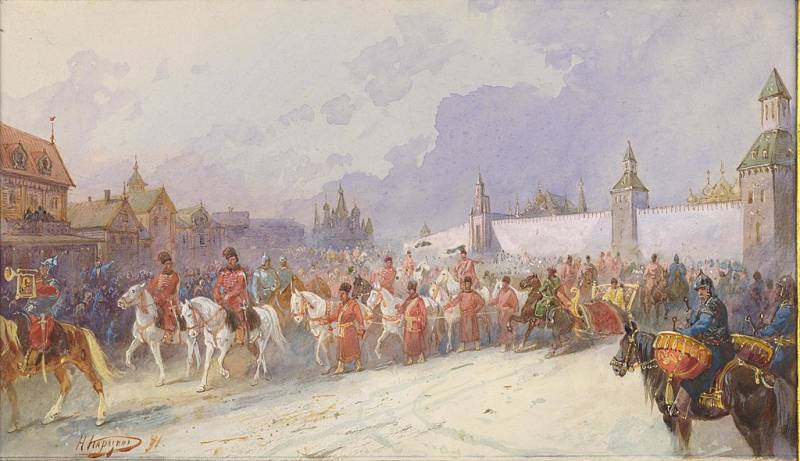
Entry of the captive Kuchumov family to Moscow. 1599. Hood. N. N. Karazin
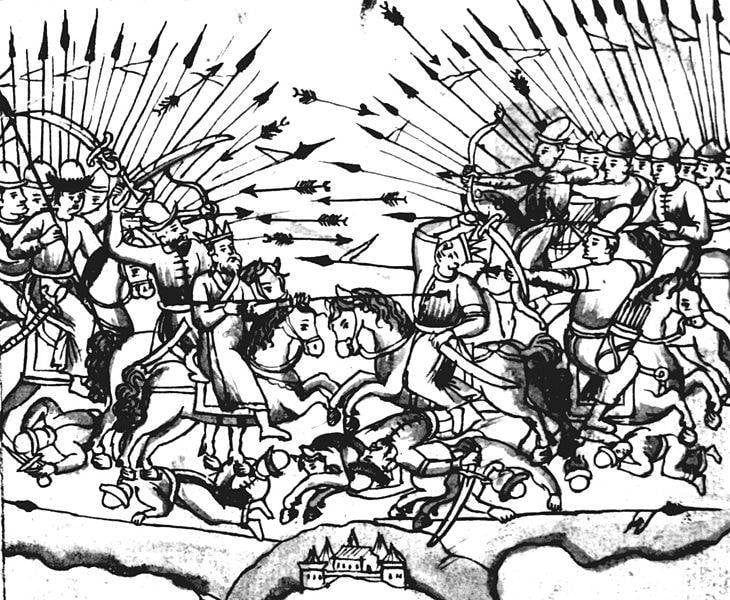
Information